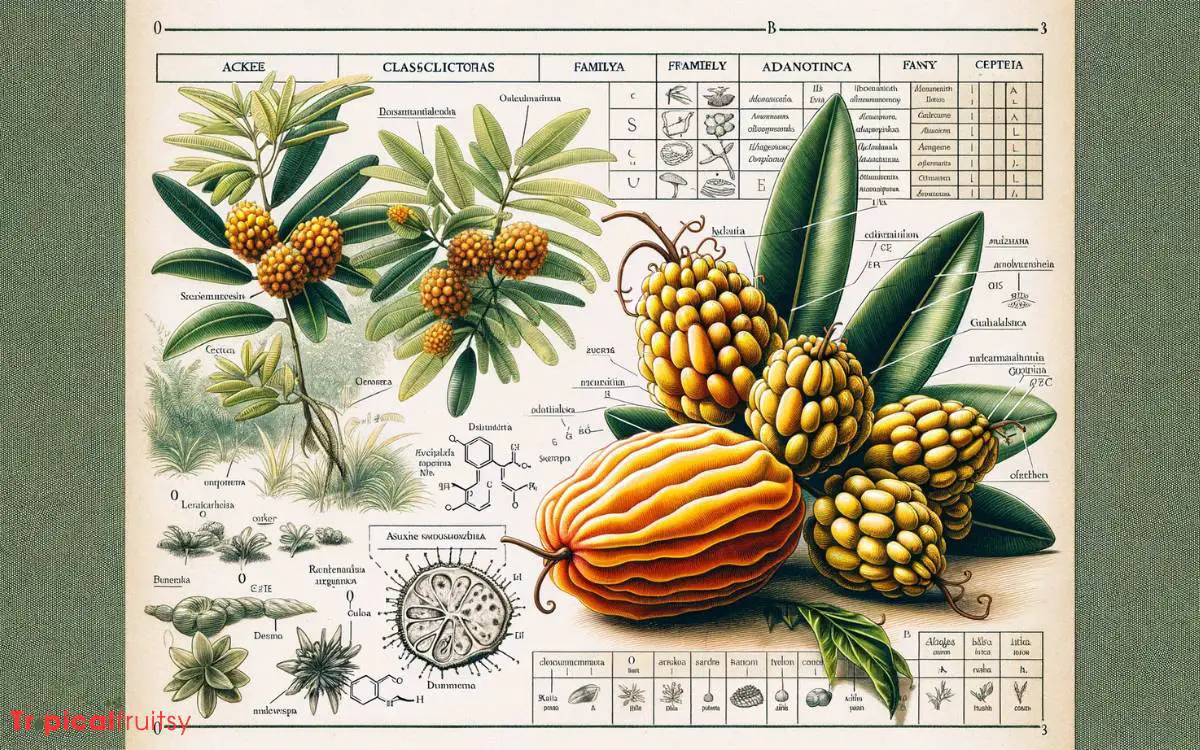Is Ackee a Fruit or Vegetable? Explained!
Ackee is a fruit, botanically classified as Blighia sapida, belonging to the Sapindaceae family. It is recognized as the national fruit of Jamaica and is celebrated for its unique appearance and culinary versatility.
Ackee is a tropical fruit characterized by its bright red shell and three large, shiny black seeds surrounded by soft, creamy yellow flesh known as arils.
Its fruit classification is based on these botanical characteristics:
Despite its fruit status, ackee is often used as a vegetable in cooking, particularly in the famous Jamaican dish, ackee and saltfish. This savory application leads to some confusion, but botanically, ackee remains a fruit.
Ackee’s savory applications in cuisine complement its botanical identity as a fruit, merging culinary innovation with natural diversity.

Key Takeaway
Botanical Profile and Culinary Uses of Blighia sapida (Ackee)
| Botanical Characteristics | Description |
|---|---|
| Family | Sapindaceae |
| Scientific Name | Blighia sapida |
| Origin | West Africa, now cultivated in Jamaica and other tropical regions |
| Edible Parts | Creamy, edible arils inside the fruit |
| Culinary Use | Often paired with savory dishes like saltfish |
| Botanical Classification | Fruit |
Understanding Ackee: Origins

Tracing the origins of ackee reveals its roots in West Africa. Before it became a staple in Jamaican cuisine, it was introduced in the 18th century.
The fruit is historically linked to the migration patterns of enslaved Africans, who valued it for its high nutritional content and versatility in various dishes.
Botanically, ackee is known as Blighia sapida, named after Captain William Bligh who transported the fruit to the British colonies.
Scientific analysis shows that the ackee’s unique characteristics have allowed it to adapt to the Caribbean environment, where it thrives today.
Its integration into local food systems underscores a complex interplay between botany, culture, and history.
To further elucidate the nature of this enigmatic fruit, a detailed examination of its botanical classification is warranted.
Botanical Classification Explained

Every ackee that grows on the evergreen Blighia sapida tree is botanically classified as a fruit, specifically a member of the soapberry family (Sapindaceae), which includes other well-known fruits like lychee and longan.
This classification is based on the ackee’s developmental origin from the ovary of the flower and its role in the reproductive process of the plant.
The fruit’s morphology is characterized by its three-lobed capsules, which at maturity, split open to reveal arillate seeds.
The presence of these seeds is a definitive characteristic that distinguishes fruits from vegetables, the latter being derived from other plant parts such as leaves, stems, or roots.
Consequently, from a botanical standpoint, ackee is unequivocally a fruit, as it fulfills the criteria of developing from the plant’s ovary and housing seeds.
Ackee in Culinary Practices

Despite its botanical identity as a fruit, ackee is often utilized as a vegetable in culinary contexts, where it imparts a distinctive flavor and texture to various dishes.
In analyzing its use, one must acknowledge the cultural and regional specificity of ackee’s culinary applications, predominantly within Caribbean cuisine.
Ackee is a primary component of the traditional Jamaican dish ackee and saltfish, where its creamy texture and mild taste juxtapose the saltiness of the cod.
Culinary experts must exercise caution, as only the arilli of mature ackee fruits are edible; the immature fruit contains hypoglycin A, a toxin.
This necessitates a precise culinary technique, ensuring the fruit is properly harvested and prepared to neutralize potential toxicity and maximize its gastronomic contribution.
Health Benefits of Ackee

Ackee, classified botanically as a fruit, offers numerous health benefits due to its rich content of essential fatty acids, dietary fiber, and vitamins.
The unique composition of ackee is associated with several positive health outcomes:
- Cardiovascular Health: The presence of unsaturated fatty acids, particularly linoleic acid, supports cardiovascular health by promoting healthy blood lipid profiles.
- Digestive Wellness: Ackee’s dietary fiber content aids in maintaining digestive health, facilitating bowel regularity and potentially reducing the risk of colorectal diseases.
- Immune System Support: With its array of vitamins, including vitamin C, ackee can bolster the immune system’s defensive mechanisms.
- Energy Metabolism: The fruit contains essential nutrients that play a role in energy metabolism, contributing to improved energy levels and vitality.
Incorporating ackee into the diet must be done cautiously, ensuring it is properly ripe and prepared to avoid toxicity.
What is the Difference between Ackee as a Fruit and its Country of Origin?
Ackee’s origin explained: Ackee is a tropical fruit native to West Africa and was brought to the Caribbean during the slave trade. The fruit is popular in Jamaican cuisine and is known for its creamy texture and slightly nutty flavor. It is important to note that while the fruit is now associated with the Caribbean, its origin lies in Africa.
Common Misconceptions Debunked

Commonly, people mistakenly classify ackee as a vegetable due to its savory applications in cooking, when in fact it is a fruit with considerable nutritional value.
This misclassification arises from a lack of familiarity with the biological criteria distinguishing fruits from vegetables, which is predicated on plant reproductive structures.
Fruits are the mature ovaries of flowering plants, often containing seeds, while vegetables are other plant parts such as leaves, stems, or roots.
Ackee, scientifically named Blighia sapida, possesses characteristic features of fruit, including seeds enclosed within a fleshy aril.
Upon reaching maturity, ackee’s arils are exposed when its protective outer pod splits open, a typical botanical phenomenon indicative of fruit.
Ackee’s culinary versatility should not obscure its categorical identity as a fruit, a classification substantiated by botanic standards.
Conclusion
In summary, ackee, authentically a fruit, belies botanical classifications with its culinary versatility.
This tropical treasure, native to West Africa, boasts beneficial bioactive compounds contributing to cardiovascular and cognitive health.
Culinary customs often cast it in a vegetable’s role, but scientifically speaking, it secures its status squarely as a fruit.
The debunking of dietary delusions demonstrates the importance of disseminating accurate information about ackee’s identity and its implications for international ingestion.






